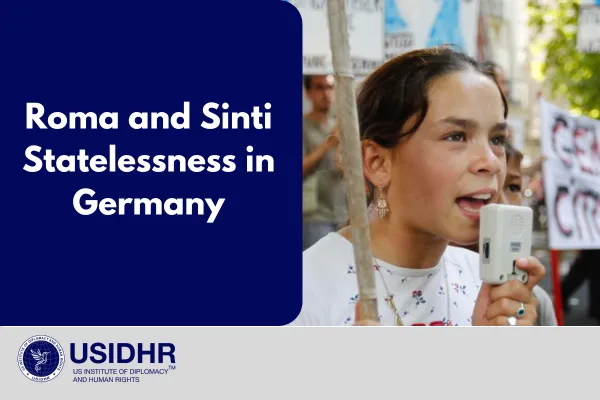
What is Statelessness?
Article 15 of the UN Declaration of Human Rights states that every person has the right to a nationality, that no one shall be arbitrarily deprived of a nationality, nor denied the right to change their nationality. A person’s nationality is a legal status that is granted to the person on the basis of where they are born or where their parent was born. It is a formal acknowledgement of a person’s belonging to a nation-state that is inherently natural or transferred through birth.
Nationality can be thought of as a birthright and grants people access to safety, protection, residence, civil rights, and other resources of the state. When people are subjected to statelessness, they are deprived of these resources by way of being deprived of nationality.
Who are the Roma and Sinti and what do we call them?
"Historical accuracy and awareness are very important when discussing the Roma and Sinti, because so much of their oppression is rooted in myths, otherization, fear-mongering, and social exclusion. Though a “Romani” nation-state has never existed, many nations consider “Romani” to be a nationality and refuse to issue nationality or citizenship to the Roma and Sinti stateless populations, many of whom can trace their heritage in Europe for generations. This leaves the Roma and Sinti unequipped with rights, access, and protection, meaning statelessness has quickly become one of the largest challenges these communities face."[1]
The Roma people first migrated to Europe from the Indian subcontinent around the year 1007[2]. Though long-standing myths characterize the Roma as migrants, most of the Roma are descendants of those who migrated to Europe (primarily Austria and Germany) around 700 years ago or earlier[2]. The term “Roma” is a self-selected term and while the Roma encourage use of this terminology in substitute of commonly used slurs, they primarily identify with distinct ethnic subgroups that are rooted linguistic/dialectal, cultural, and territorial distinctions. There are various Romani subgroups and the ethonym “Sinti” is a self-selected phrase that the main group of Roma who reside in German-speaking countries reference themselves as. Of the estimated 200,000-300,000 Roma in Germany, around one-third belong to the Sinti group[3].
How many Roma and Sinti are stateless?
Because census data was weaponized against ethnic minorities and vulnerable groups during the Holocaust, most European countries (especially Germany) have very strict data privacy laws that prevent institutions from collecting data about race, religion, and ethnicity. Thus, we only know the estimated number of Roma and Sinti who exist in Germany and their citizenship status.
Government and advocacy coalitions must rely on estimates of data when raising issues of poverty, homelessness, and statelessness. Of the estimated 200,000-300,000 Roma and Sinti people residing in Germany, it is estimated that only 70,000 are recognized as German nationals or citizens[4]. Projected figures place the Roma and Sinti as the largest ethnic minority group in Europe, but roughly 70% of Roma and Sinti remain stateless.
If the Roma and Sinti have been in Europe and German-speaking areas for so long, why aren’t they nationals or citizens?
The Roma and Sinti whose ancestry in German-speaking regions dates back to the 14th and 15th century are generally more likely to hold German citizenship. However, there are two other main waves of Roma and Sinti who migrated to Germany.
Many of these Roma and Sinti are migrants from Eastern Europe. Some members of this group are from former Yugoslavia and arrived in Germany between 1968 and 1973 after a bilateral agreement to recruit workers from former Yugoslavia[3]. The majority of these Roma and Sinti are not German nationals or citizens but do have work and residence permits.
Another group of Roma and Sinti are refugees from primarily Eastern Europe, who arrived in the early 1990s. Of the estimated 60,000 Roma and Sinti who applied for asylum, nearly all were rejected[5]. The remaining refugees who have arrived in Germany since then have primarily come from the former Yugoslavian state, following the Kosovo war. Many of these people were granted the “toleration” protection status, which essentially amounted to a temporary (yearlong) postponement of deportation and does not substitute for a residence or work permit.
Why is nationality and citizenship important?
Exclusion from nationality and citizenship makes it difficult for this Roma and Sinti group to gain employment. Germany has a priority check policy, meaning employers must prioritize European Union (EU) citizens, European Economic Area (EEA) citizens, and legal residents over non-citizens and non-residents. Roma and Sinti who are German nationals are also granted the status of a national minority in the Council of Europe’s Framework Convention for the Protection of National Minorities
. The Framework Convention includes the rights to preserve and practice one’s culture, religion, and language, protection from forced integration, protection from discrimination, etc. The national minority status and the special rights and protections it entails is not extended to Roma and Sinti people who do not hold German citizenship[3]. Stateless Roma and Sinti are largely ignored by the state, and are not extended the welfare benefits that other German and EU residents and nationals enjoy. This societal distrust and discrimination has resulted in institutional racism against the Roma and Sinti, in disproportional violent policing of these groups, exclusion from social programs, and discriminatory punishment and harassment in schools[6].
As a result of centuries of institutional racism and discrimination, the Roma and Sinti have developed a high level of distrust toward both German and European institutions[7]. Thus, they are hesitant to participate in institutions and resources such as public schooling, hospitals, and social housing, even if it were made entirely accessible to them[7]. The lack of access and distrust of institutions perpetuates the cyclical poverty that Roma and Sinti communities are plagued with. Roma and Sinti children experience higher levels of school absences and drop-out rates, lower scores, and lower rates of achieving higher education. This is aggravated by attempts to exclude Roma and Sinti children from public schools by non-Roma and Sinti parents and teachers, as well as Roma and Sinti parents who fear forced assimilation and historical accounts of discrimination[7]. Furthermore, while the state can enforce school attendance for German nationals and legal residents, they cannot for the stateless.
Conclusion:
Statelessness is a dangerous condition that leaves hundreds of thousands of Roma and Sinti stripped of access and basic human rights. Given the history of systemic discrimination and abuse of these communities, offering a pathway to citizenship alone will not fix the issue, as many are so distrustful of the government. Rather, the German government (as well as neighboring countries) must instill trust in the government and its institutions by recognizing the human rights of the Roma and Sinti, even as they do not hold citizenship. This includes extending and incentivizing quality education that caters to the cultural and lingual needs of the community, public housing with adequate living conditions, and welfare benefits that alleviate poverty experienced in Roma and Sinti communities.
Statelessness is one of many human rights violations committed against ethnic minorities and other marginalized people in the world. If you are interested in learning more about global human rights issues, feel free to sign up for and attend our free Human Rights and Diplomacy Summit, which will take place on November 18-19, 2021. More information can be found here: https://usa.usidhr.org/usidhrsummit
Reference list:
[1]. Margalit, G., & Matras, Y. (2007). G*psies in Germany – German G*psies? Identity and politics of Sinti and Roma in Germany. In R. Stauber, & R. Vago (Eds.), The Roma: A minority in Europe. Historical, social and cultural perspectives. Berghahn Books Inc.
[2]. Constantine, Simon. (2020). Sinti and Roma in Germany (1871-1933): G*psy policy in the Second Empire and Weimar Republic (Routledge Studies in Modern European History). London: Routledge.
[3]. Lüken-Klaßen, D., & Meixner, S. (2004). Roma in Public Education. RAXEN. European Forum for Migration Studies Institution at the University Bamberg.
[4]. Reuss, Anja; Mack, Jonathan. Data Collection on Equality, Discrimination and Antig*psyism. (2011) Heidelberg: Central Council of German Sinti and Roma.
[5]. Margalit, G., & Matras, Y. (2007). Again, for the context of asylum and refugees.
[6]. Gómez, Ismael Cortés; End, Markus. (2019). Dimensions of Antig*psyism in Europe. Brussels: European Network Against Racism.
[7]. Strauss, Daniel. (2012). Study on the Current Educational Situation of German Sinti and Roma.
Join One of Our Certificate Trainings:

Human Rights Education Certification Training

Human Trafficking Certification
Training

International Business and Diplomatic Protocol Certification

Capacitación En Derechos Humanos

Business Consulting Certification Training

Digital Citizenship Certification
Training

The US Institute of Diplomacy and Human Rights (USIDHR) is an International Continuing Professional Development (CPD) Accredited Organization. Accredited CPD training means the learning activity has reached the required Continuing Professional Development standards and benchmarks. The learning value has been scrutinized to ensure integrity and quality. The CPD Certification Service provides recognized independent CPD accreditation compatible with global CPD requirements

US Institute Of Diplomacy And Human Rights
1250 Connecticut Ave NW Ste 700, Washington, DC 20036




